中考英语被动语态考点归纳与例析
- 格式:doc
- 大小:38.50 KB
- 文档页数:6
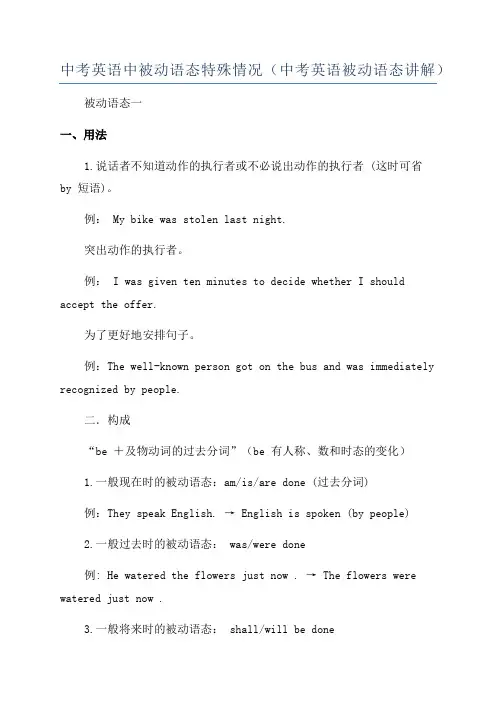
中考英语中被动语态特殊情况(中考英语被动语态讲解)被动语态一一、用法1.说话者不知道动作的执行者或不必说出动作的执行者 (这时可省by 短语)。
例: My bike was stolen last night.突出动作的执行者。
例: I was given ten minutes to decide whether I shouldaccept the offer.为了更好地安排句子。
例:The well-known person got on the bus and was immediately recognized by people.二.构成“be +及物动词的过去分词”(be 有人称、数和时态的变化)1.一般现在时的被动语态:am/is/are done (过去分词)例:They speak English. → English is spoken (by people)2.一般过去时的被动语态: was/were done例: He watered the flowers just now . → The flowers were watered just now .3.一般将来时的被动语态: shall/will be done例:We will clean the classroom. → The classroom will be cleaned (by us ) .4.现在进行时的被动语态:am/is /are being done例:Tom is picking apples . → Apples are being picking by Tom5.过去进行时的被动语态 was/were being done6.现在完成时的被动语态: has /have been done例; The workers have built a house. → A house has beenbuilt by the workers .7.过去完成时的被动语态:had been done8.过去将来时的被动语态:should/would be done例:You would look after him well . → He would be looked after well .9.情态动词的被动语态:情态动词+be+过去分词例:The baby should be taken good care of by the baby-sitter.三.步骤主动语态变被动语态1、找:找主语、找宾语(找原主动句中的主语和宾语)2、换:换位置,主语变宾语,宾语变主语3、改:动词改成be done的被动形式(其人称和数随主语变化,动词时态则保持不变)4、加:加by( 宾格),加附属(定语、状语),by 宾格可省略。
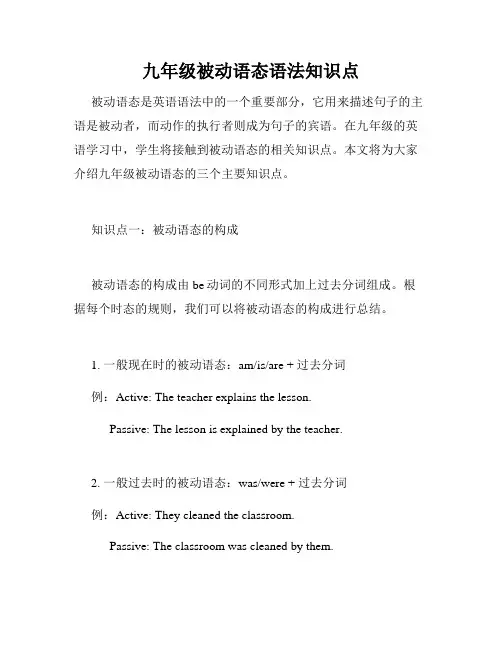
九年级被动语态语法知识点被动语态是英语语法中的一个重要部分,它用来描述句子的主语是被动者,而动作的执行者则成为句子的宾语。
在九年级的英语学习中,学生将接触到被动语态的相关知识点。
本文将为大家介绍九年级被动语态的三个主要知识点。
知识点一:被动语态的构成被动语态的构成由be动词的不同形式加上过去分词组成。
根据每个时态的规则,我们可以将被动语态的构成进行总结。
1. 一般现在时的被动语态:am/is/are + 过去分词例:Active: The teacher explains the lesson.Passive: The lesson is explained by the teacher.2. 一般过去时的被动语态:was/were + 过去分词例:Active: They cleaned the classroom.Passive: The classroom was cleaned by them.3. 一般将来时的被动语态:will be + 过去分词例:Active: She will write a letter.Passive: A letter will be written by her.4. 现在进行时的被动语态:am/is/are + being + 过去分词例:Active: They are building a new house.Passive: A new house is being built by them.5. 过去进行时的被动语态:was/were + being + 过去分词例:Active: He was repairing his bike.Passive: His bike was being repaired by him.6. 现在完成时的被动语态:has/have been + 过去分词例:Active: She has written a book.Passive: A book has been written by her.知识点二:被动语态的用法被动语态在英语中有着重要的应用。
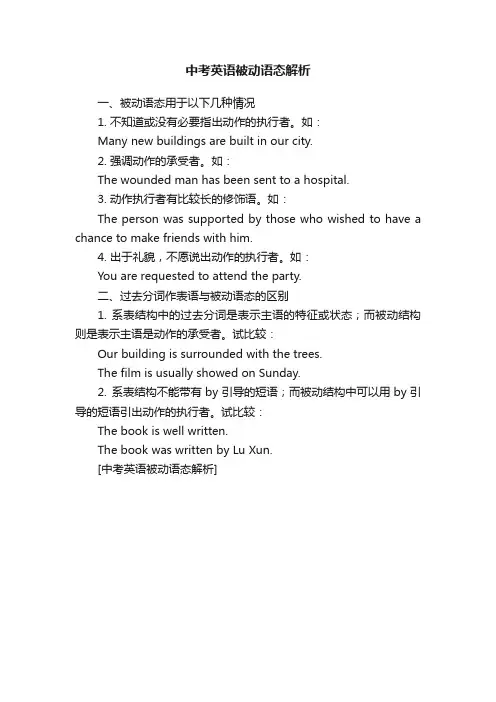
中考英语被动语态解析
一、被动语态用于以下几种情况
1. 不知道或没有必要指出动作的执行者。
如:
Many new buildings are built in our city.
2. 强调动作的承受者。
如:
The wounded man has been sent to a hospital.
3. 动作执行者有比较长的修饰语。
如:
The person was supported by those who wished to have a chance to make friends with him.
4. 出于礼貌,不愿说出动作的执行者。
如:
You are requested to attend the party.
二、过去分词作表语与被动语态的区别
1. 系表结构中的过去分词是表示主语的特征或状态;而被动结构则是表示主语是动作的承受者。
试比较:
Our building is surrounded with the trees.
The film is usually showed on Sunday.
2. 系表结构不能带有by引导的短语;而被动结构中可以用by引导的短语引出动作的执行者。
试比较:
The book is well written.
The book was written by Lu Xun.
[中考英语被动语态解析]。
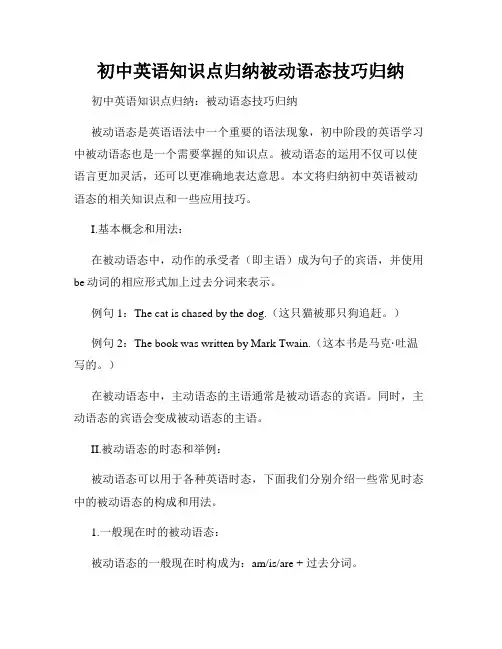
初中英语知识点归纳被动语态技巧归纳初中英语知识点归纳:被动语态技巧归纳被动语态是英语语法中一个重要的语法现象,初中阶段的英语学习中被动语态也是一个需要掌握的知识点。
被动语态的运用不仅可以使语言更加灵活,还可以更准确地表达意思。
本文将归纳初中英语被动语态的相关知识点和一些应用技巧。
I.基本概念和用法:在被动语态中,动作的承受者(即主语)成为句子的宾语,并使用be动词的相应形式加上过去分词来表示。
例句1:The cat is chased by the dog.(这只猫被那只狗追赶。
)例句2:The book was written by Mark Twain.(这本书是马克·吐温写的。
)在被动语态中,主动语态的主语通常是被动语态的宾语。
同时,主动语态的宾语会变成被动语态的主语。
II.被动语态的时态和举例:被动语态可以用于各种英语时态,下面我们分别介绍一些常见时态中的被动语态的构成和用法。
1.一般现在时的被动语态:被动语态的一般现在时构成为:am/is/are + 过去分词。
例句1:The window is cleaned by me every week.(这扇窗户每周都被我清理。
)例句2:English books are read by students in the library.(学生们在图书馆阅读英语书。
)2.一般过去时的被动语态:被动语态的一般过去时构成为:was/were + 过去分词。
例句1:The cake was eaten by him yesterday.(这个蛋糕昨天被他吃掉了。
)例句2:The letter was sent by my mother last week.(这封信是我妈妈上周寄出的。
)3.一般将来时的被动语态:被动语态的一般将来时构成为:will be + 过去分词。
例句1:The party will be held by us next month.(派对将由我们来举办。
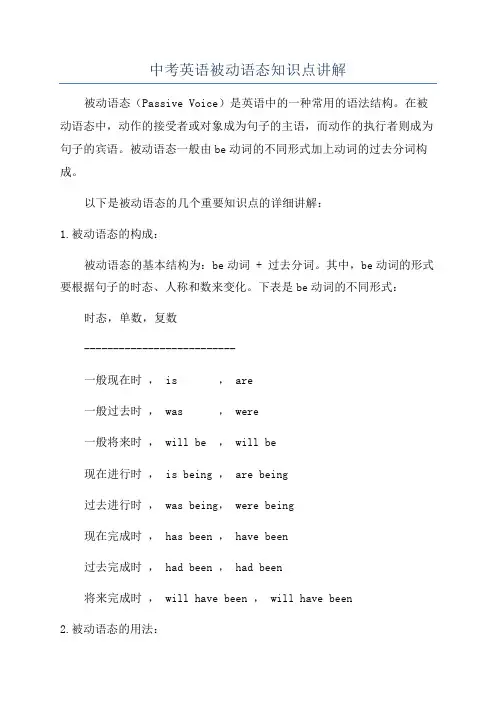
中考英语被动语态知识点讲解被动语态(Passive Voice)是英语中的一种常用的语法结构。
在被动语态中,动作的接受者或对象成为句子的主语,而动作的执行者则成为句子的宾语。
被动语态一般由be动词的不同形式加上动词的过去分词构成。
以下是被动语态的几个重要知识点的详细讲解:1.被动语态的构成:被动语态的基本结构为:be动词 + 过去分词。
其中,be动词的形式要根据句子的时态、人称和数来变化。
下表是be动词的不同形式:时态,单数,复数--------------------------一般现在时, is , are一般过去时, was , were一般将来时, will be , will be现在进行时, is being , are being过去进行时, was being, were being现在完成时, has been , have been过去完成时, had been , had been将来完成时, will have been , will have been2.被动语态的用法:被动语态常用于以下情况:- 当行为执行者不重要或不知道时,一般用被动语态。
例如:The car was repaired yesterday.(这辆车昨天被修好了。
)- 当强调动作的承受者而不是执行者时,使用被动语态。
例如:The book was written by a famous author.(这本书是由一位著名作家写的。
)- 当句子的主语是一个无生命的物体时,常用被动语态。
例如:The window was broken by the wind.(窗户被风摔坏了。
)3.需要注意的细节:- 当句子的主语是第三人称单数时,be动词的形式要用is,而不是are。
例如:The book is being read by my sister.(这本书正在我妹妹看。
)- 当使用被动语态时,动词的过去分词形式要正确使用。
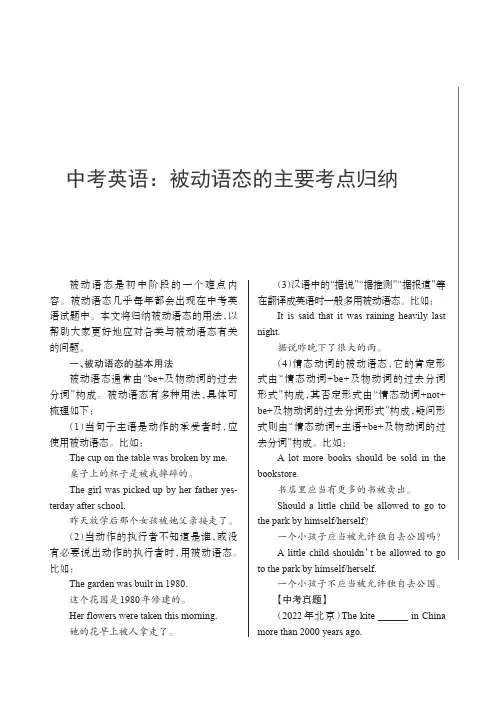
被动语态是初中阶段的一个难点内容。
被动语态几乎每年都会出现在中考英语试题中。
本文将归纳被动语态的用法,以帮助大家更好地应对各类与被动语态有关的问题。
一、被动语态的基本用法被动语态通常由“be+及物动词的过去分词”构成。
被动语态有多种用法,具体可梳理如下:(1)当句子主语是动作的承受者时,应使用被动语态。
比如:The cup on the table was broken by me.桌子上的杯子是被我摔碎的。
The girl was picked up by her father yes-terday after school.昨天放学后那个女孩被她父亲接走了。
(2)当动作的执行者不知道是谁,或没有必要说出动作的执行者时,用被动语态。
比如:The garden was built in1980.这个花园是1980年修建的。
Her flowers were taken this morning.她的花早上被人拿走了。
(3)汉语中的“据说”“据推测”“据报道”等在翻译成英语时一般多用被动语态。
比如:It is said that it was raining heavily last night.据说昨晚下了很大的雨。
(4)情态动词的被动语态,它的肯定形式由“情态动词+be+及物动词的过去分词形式”构成,其否定形式由“情态动词+not+ be+及物动词的过去分词形式”构成,疑问形式则由“情态动词+主语+be+及物动词的过去分词”构成。
比如:A lot more books should be sold in the bookstore.书店里应当有更多的书被卖出。
Should a little child be allowed to go to the park by himself/herself?一个小孩子应当被允许独自去公园吗?A little child shouldn’t be allowed to go to the park by himself/herself.一个小孩子不应当被允许独自去公园。
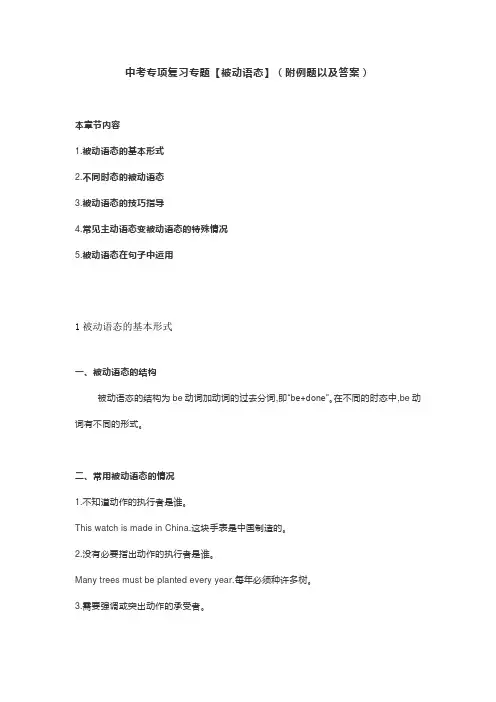
中考专项复习专题【被动语态】(附例题以及答案)本章节内容1.被动语态的基本形式2.不同时态的被动语态3.被动语态的技巧指导4.常见主动语态变被动语态的特殊情况5.被动语态在句子中运用1被动语态的基本形式一、被动语态的结构被动语态的结构为be动词加动词的过去分词,即“be+done”。
在不同的时态中,be动词有不同的形式。
二、常用被动语态的情况1.不知道动作的执行者是谁。
This watch is made in China.这块手表是中国制造的。
2.没有必要指出动作的执行者是谁。
Many trees must be planted every year.每年必须种许多树。
3.需要强调或突出动作的承受者。
Chinese is spoken by more and more people in the world.世界上越来越多的人说汉语。
(强调汉语的广泛使用)4.动作的发出者是物。
Many houses were washed away by the flood.许多房子被洪水冲走了。
2不同时态的被动语态1.时态和语态的结合是中考的必考点,尤其是一般现在时、一般过去时和一般将来时的被动语态。
2.其他时态的被动语态3.含有情态动词的被动语态结构为“情态动词+be+done”。
Your homework must be finished today.你的作业今天必须完成。
3被动语态的技巧指导(1)根据选项定考点单项填空对语态的考查均会结合时态,4个选项中一般包含两个主动语态,两个被动语态;而其对时态的考查一般不会涉及语态。
因此,如果选项中出现被动语态,即可判断此题考查被动语态,由此便可排除非被动语态的选项。
(2)根据时态选答案首先,考生需要根据关键词(时间状语)来判断时态。
对于没有关键词的试题,则要根据上下文已经给出的时态、语境理解并结合常识进行判断。
如:—Tell me one thing you’re proud of in your junior high school, Tony.—I ___ as the captain of the school football team.A. chooseB. choseC. am chosenD. was chosen方法点拨第1步:根据选项A、B为时态,C、D为被动语态可知本题考查被动语态,因此可排除A、B两项。
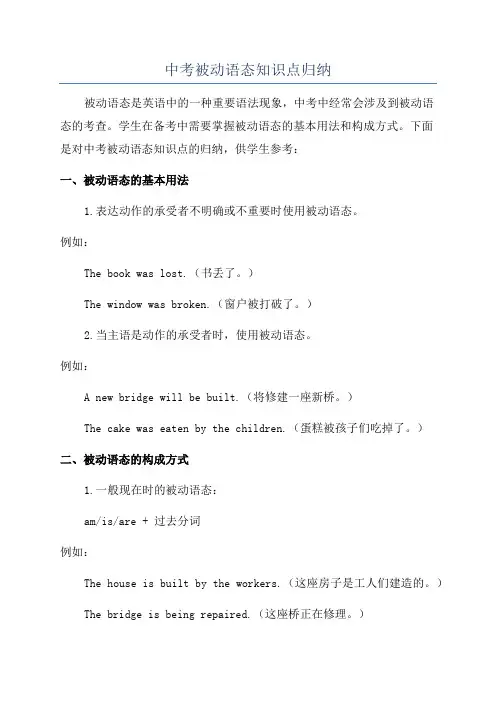
中考被动语态知识点归纳被动语态是英语中的一种重要语法现象,中考中经常会涉及到被动语态的考查。
学生在备考中需要掌握被动语态的基本用法和构成方式。
下面是对中考被动语态知识点的归纳,供学生参考:一、被动语态的基本用法1.表达动作的承受者不明确或不重要时使用被动语态。
例如:The book was lost.(书丢了。
)The window was broken.(窗户被打破了。
)2.当主语是动作的承受者时,使用被动语态。
例如:A new bridge will be built.(将修建一座新桥。
)The cake was eaten by the children.(蛋糕被孩子们吃掉了。
)二、被动语态的构成方式1.一般现在时的被动语态:am/is/are + 过去分词例如:The house is built by the workers.(这座房子是工人们建造的。
)The bridge is being repaired.(这座桥正在修理。
)2.一般过去时的被动语态:was/were + 过去分词例如:The book was written by Mark Twain.(这本书是马克吐温写的。
)The cake was made by my mother.(这个蛋糕是我妈妈做的。
)3.现在进行时的被动语态:am/is/are + being + 过去分词例如:The letter is being written by Tom.(这封信是汤姆在写。
)The garden is being watered by my father.(这个花园正在被我爸爸浇水。
)4.过去进行时的被动语态:was/were + being + 过去分词例如:The house was being built when it started raining.(这座房子在下雨时正在建造。
)The car was being repaired in the garage.(这辆车在车库里正在修理。
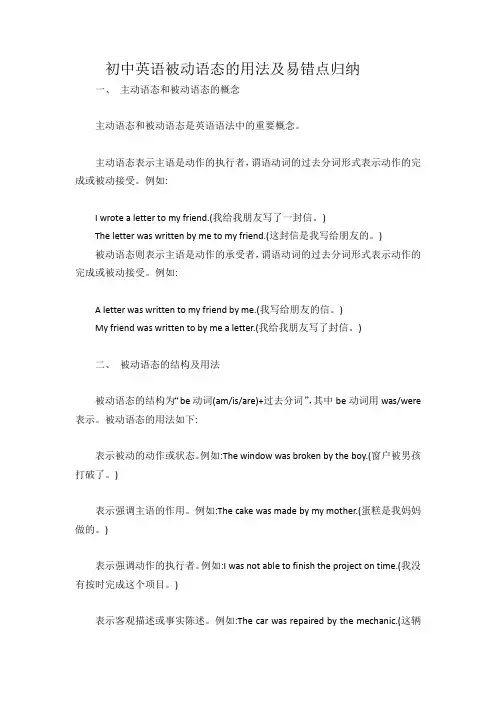
初中英语被动语态的用法及易错点归纳一、主动语态和被动语态的概念主动语态和被动语态是英语语法中的重要概念。
主动语态表示主语是动作的执行者,谓语动词的过去分词形式表示动作的完成或被动接受。
例如:I wrote a letter to my friend.(我给我朋友写了一封信。
)The letter was written by me to my friend.(这封信是我写给朋友的。
)被动语态则表示主语是动作的承受者,谓语动词的过去分词形式表示动作的完成或被动接受。
例如:A letter was written to my friend by me.(我写给朋友的信。
)My friend was written to by me a letter.(我给我朋友写了封信。
)二、被动语态的结构及用法被动语态的结构为“be动词(am/is/are)+过去分词”,其中be动词用was/were 表示。
被动语态的用法如下:表示被动的动作或状态。
例如:The window was broken by the boy.(窗户被男孩打破了。
)表示强调主语的作用。
例如:The cake was made by my mother.(蛋糕是我妈妈做的。
)表示强调动作的执行者。
例如:I was not able to finish the project on time.(我没有按时完成这个项目。
)表示客观描述或事实陈述。
例如:The car was repaired by the mechanic.(这辆车是由机械师修理的。
)用于疑问句和否定句中。
例如:Was the movie good?(这部电影好吗?)He was not able to finish the project on time.(他没有按时完成这个项目。
)2)不同时态中的被动语态被动语态是英语中常用的一种语态形式,用于表示动作的承受者。
在使用时,需要注意不同时态的被动语态结构。
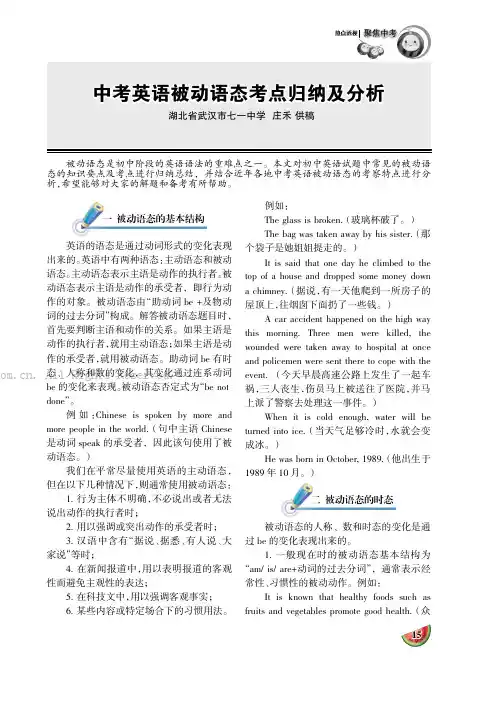
热点透视聚焦中考中考英语被动语态考点归纳及分析湖北省武汉市七一中学庄禾供稿一、被动语态的基本结构英语的语态是通过动词形式的变化表现出来的。
英语中有两种语态:主动语态和被动语态。
主动语态表示主语是动作的执行者。
被动语态表示主语是动作的承受者,即行为动作的对象。
被动语态由“助动词be+及物动词的过去分词”构成。
解答被动语态题目时,首先要判断主语和动作的关系。
如果主语是动作的执行者,就用主动语态;如果主语是动作的承受者,就用被动语态。
助动词be有时态、人称和数的变化,其变化通过连系动词be的变化来表现。
被动语态否定式为“be not done”。
例如:Chinese is spoken by more and more people in the world.(句中主语Chinese 是动词speak的承受者,因此该句使用了被动语态。
)我们在平常尽量使用英语的主动语态,但在以下几种情况下,则通常使用被动语态:1.行为主体不明确,不必说出或者无法说出动作的执行者时;2.用以强调或突出动作的承受者时;3.汉语中含有“据说、据悉、有人说、大家说”等时;4.在新闻报道中,用以表明报道的客观性而避免主观性的表达;5.在科技文中,用以强调客观事实;6.某些内容或特定场合下的习惯用法。
例如:The glass is broken.(玻璃杯破了。
)The bag was taken away by his sister.(那个袋子是她姐姐提走的。
)It is said that one day he climbed to the top of a house and dropped some money down a chimney.(据说,有一天他爬到一所房子的屋顶上,往烟囱下面扔了一些钱。
)A car accident happened on the high way this morning.Three men were killed,the wounded were taken away to hospital at once and policemen were sent there to cope with the event.(今天早晨高速公路上发生了一起车祸,三人丧生,伤员马上被送往了医院,并马上派了警察去处理这一事件。
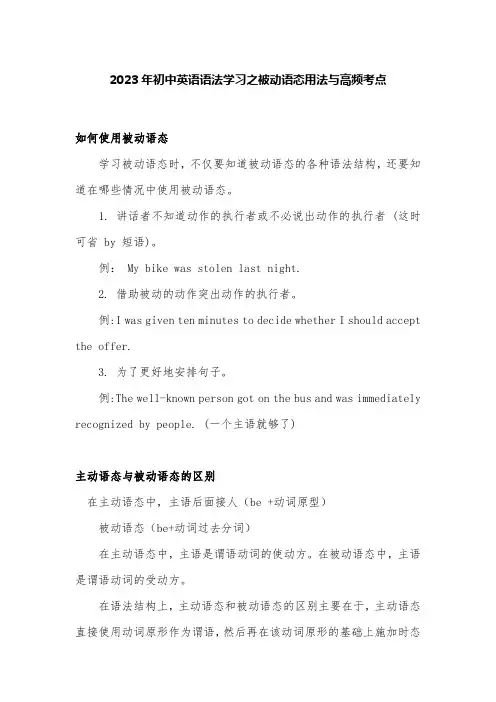
2023年初中英语语法学习之被动语态用法与高频考点如何使用被动语态学习被动语态时,不仅要知道被动语态的各种语法结构,还要知道在哪些情况中使用被动语态。
1. 讲话者不知道动作的执行者或不必说出动作的执行者 (这时可省 by 短语)。
例: My bike was stolen last night.2. 借助被动的动作突出动作的执行者。
例:I was given ten minutes to decide whether I should accept the offer.3. 为了更好地安排句子。
例:The well-known person got on the bus and was immediately recognized by people. (一个主语就够了)主动语态与被动语态的区别在主动语态中,主语后面接人(be +动词原型)被动语态(be+动词过去分词)在主动语态中,主语是谓语动词的使动方。
在被动语态中,主语是谓语动词的受动方。
在语法结构上,主动语态和被动语态的区别主要在于,主动语态直接使用动词原形作为谓语,然后再在该动词原形的基础上施加时态和其他语法;而被动语态则使用系词+动词的过去分词作为谓语,各种时态和其他语法也施加在系词上。
举例:1.主动语态:The snowslide killed him. 雪崩害死了他。
被动语态:He was killed by the snowslide. 他死于雪崩。
2.主动语态:We use electricity to run machines. 我们用电力来开动机器。
被动语态:Electricity is used to run machines. 电力被我们用来开动机器。
3.主动语态:Bell invented the telephone in 1876.贝尔于1876年发明了电话。
被动语态:The telephone was invented by Bell in1876.电话是贝尔于1876年发明的。
中考被动语态详细讲解与练习知识点1:被动语态的基本知识1. 语态:英语的语态是通过动词的形式表现出来的,用来表明主语与谓语动词之间的关系,英语的动词有两种语态形式,即主动语态和被动语态。
如果主语是动作的执行者,谓语动词用主动语态。
如果主语是动作的对象,谓语动词用被动语态。
2. 主动语态与被动语态的转化:①将主动语态的宾语改为被动语态的主语;②将主动语态的谓语动词改为“be+过去分词”结构;③将主动语态的主语改为介词by之后的宾语,放在谓语动词之后(有时可省略)。
例:Wevisitedthat factorylast summer.→主动语态主语谓语宾语状语That factorywas visitedby uslast summer→被动语态主语谓语宾语状语3. 用法:被动语态常用于以下两种情况:(1)不知道谁是动作的执行者,或者没有必要指出谁是动作的执行者;例:This cloth is made of cotton.(2)强调动作的承受者。
例:Her bike is stolen .例题1:单选题1:(2012福建福州) — Our classroom____________every day.—So it is. It's our duty to keep it clean and tidy.A. cleansB. is cleaningC. is cleanedD. cleaning2:(2013陕西)The mobile phone has influenced people’s life a lot since it _________.A. inventsB. inventedC. is inventedD. was invented3:(2013江苏南京)It is said that an Asian Culture Village inside the AYG, Village in Nanjing in the coming Asian Youth Games period.A. buildsB. is buildingC. will be builtD. was built4:(2013内蒙古呼和浩特)People who ________ to the party are very excited.A. have invitedB. has been invitedC. will inviteD. have been invited5:(2013湖北黄冈)—How often do I need to feed the dog?— It ___ food every day, or it will be hungry.A. must giveB. must be giveC. must be givenD. must be gave6:The new suspension bridge ___ by the end of last month.A. has been designedB. had been designedC. was designedD. would be designed CDCDCB例题2:用括号内动词的适当形式填空1.she _______________ (tell) the good news as soon as it arrived.2.A lot of work __________________(do) for the poor kids in the past few years.3.The book ________________ (write) by the young girl several years ago.4.All the tickets __________(sell) out when we got to the cinema.5.A new building __________(build) at our school now.6.I don't believe you've already finished reading the book which ________(lend) to you this morning!was told。
中考英语被动语态知识点整理在中考英语中,被动语态是一个重要的语法知识点。
理解和掌握被动语态对于我们正确运用英语、提高语言表达能力有着重要的意义。
接下来,让我们一起对中考英语被动语态的相关知识进行全面的整理。
一、被动语态的基本概念被动语态表示主语是动作的承受者,即行为动作的对象。
例如:“The book is read by me”(这本书被我读。
)在这个句子中,“the book”是动作“read”的承受者,而不是执行者。
二、被动语态的构成被动语态由“be 动词+及物动词的过去分词”构成。
其中,be 动词的形式根据时态和主语的人称、数而变化。
1、一般现在时的被动语态:am/is/are +过去分词例如:“English is spoken all over the world”(英语在全世界被说。
)2、一般过去时的被动语态:was/were +过去分词例如:“The bridge was built last year”(这座桥去年被建造。
)3、一般将来时的被动语态:will be +过去分词或 be going to be+过去分词例如:“The sports meeting will be held next week”(运动会将在下周举行。
)4、现在进行时的被动语态:am/is/are + being +过去分词例如:“The problem is being discussed now”(这个问题正在被讨论。
)5、过去进行时的被动语态:was/were + being +过去分词例如:“The house was being painted when I arrived”(我到达时,房子正在被粉刷。
)6、现在完成时的被动语态:have/has been +过去分词例如:“Many trees have been planted by us”(我们已经种了很多树。
)7、过去完成时的被动语态:had been +过去分词例如:“The work had been finished before he came”(在他来之前,工作已经完成了。
【英语】动词被动语态考点+例题-全面解析经典一、动词被动语态1.—A new bridge in our hometown last year.— Really? Our hometown must be more beautiful.A. is builtB. was builtC. built【答案】 B【解析】【分析】句意:-去年,在我们故乡建了一座新的桥梁。
-真的吗?我们故乡一定更美了。
A. is built一般现在时态的被动语态;B. was built一般过去时态的被动语态;C. built一般过去时态的主动语态。
本题描述的是去年发生的过去动作,句子用一般过去时态;主语bridge是谓语动词build的承受者,句子用被动语态。
故选B。
【点评】此题考查一般过去时的被动语态。
2. The 31st Olympic Games _______ in Rio de Janeiro of Brazil in 2016.A. is heldB. will holdC. will be heldD. is going to hold【答案】C【解析】【分析】句意:第31届奥运会将于2016年在巴西里约热内卢举行。
举办奥运会,The 31st Olympic Games在句中作主语,用被动语态。
2016年将要发生的动作,用一般将来时态。
故选C。
3.The students of Class One_________ how to do the experiment in class yesterday.A. taughtB. was taughtC. were taught【答案】 C【解析】【分析】句意是:在昨天的课堂上学生们被教了怎样做实验。
根据句意可知用被动语态,主语students 是名词复数形式,be 动词用 were,故选C。
【点评】考查一般过去时的被动语态的用法。
4.The telephone____by Alexander Graham Bell in 1876.A. is inventedB. was inventedC. were invented【答案】 B【解析】【分析】句意:电话是1876年亚历山大·格拉汉姆·贝尔发明的。
中考中的被动语态知识点总结与归纳被动语态是英语语法中一个重要的知识点,也是中考英语考试中常见的题型。
理解和掌握被动语态的用法对于学生来说至关重要。
本文将对中考中的被动语态知识点进行总结和归纳,帮助学生全面了解和掌握该知识点。
一、被动语态的构成和用法被动语态的构成:主语+be动词(根据时态变化)+过去分词被动语态的用法:1. 当我们不知道或不想提及动作的执行者时。
例句:The car was stolen last night.(昨晚这辆车被偷了。
)2. 当我们想强调动作的承受者时。
例句:The book was written by a famous author.(这本书是一位著名作家写的。
)3. 当我们想表达客观事实时。
例句:The Great Wall was built in the Qin Dynasty.(长城始建于秦朝。
)二、被动语态的各种时态1. 一般现在时的被动语态构成:am/is/are + 过去分词例句:The letter is written in English.(这封信用英语写的。
)2. 一般过去时的被动语态构成:was/were + 过去分词例句:The cake was eaten by the children.(蛋糕被孩子们吃掉了。
)3. 一般将来时的被动语态构成:will be + 过去分词例句:The meeting will be held next Monday.(会议将在下周一举行。
)4. 现在进行时的被动语态构成:am/is/are being + 过去分词例句:The house is being built at the moment.(这座房子正在建造中。
)5. 过去进行时的被动语态构成:was/were being + 过去分词例句:The car was being repaired when I arrived.(当我到达时,汽车正在修理中。
初三知识点总结被动语态被动语态是英语语法中的一种重要形式,它用于强调动作的接受者而不是执行者。
在初三学年,学生已经学习了被动语态的基本概念和用法。
本文将对初三学生在学习被动语态过程中需要掌握的知识进行总结。
一、被动语态的构成被动语态由助动词be+过去分词构成。
根据时态的不同,be的形式会发生变化。
1. 现在时态的被动语态:am/is/are + 过去分词例如:Active: Tom eats an apple.Passive: An apple is eaten by Tom.2. 过去时态的被动语态:was/were + 过去分词例如:Active: Lisa wrote a letter.Passive: A letter was written by Lisa.3. 将来时态的被动语态:will be + 过去分词例如:Active: They will build a new hospital.Passive: A new hospital will be built by them.二、主动语态和被动语态的转换在学习被动语态时,初三学生需要学会主动语态和被动语态的相互转换。
具体转换规则如下:1. 直接宾语转换:将主动语态中的直接宾语变为被动语态中的主语。
例如:Active: They eat apples.Passive: Apples are eaten by them.2. 双宾语转换:将主动语态中的间接宾语变为被动语态中的主语,直接宾语变为介词by短语。
例如:Active: He gave me a book.Passive: I was given a book by him.3. 无宾语动词转换:将主动语态中的无宾语动词转换为被动语态时,需加上介词by和动词的进行时态。
例如:Active: They swim in the pool.Passive: The pool is being swum in by them.三、被动语态的用法被动语态在英语中有多种用途,以下是初三学生应掌握的主要用法:1. 主动语态的被动表达:当我们不知道或不关心动作的执行者时,可以使用被动语态。
中考被动语态考点梳理语态有“积极”与“被动”两种。
积极语态表达主语与谓语之间形成旳是主谓关系, 例如“某人做某事、某事发生了”等。
被动语态则表达主语与谓语之间形成旳是动宾关系, 例如“某人被告知某事、某事被做了”等。
我们在解答被动语态试题时, 应理解中考有关被动语态旳命题特点, 做到如下“六注意”:一、注意题中有“陷阱”部分考察积极语态旳单选题, 常以动词旳被动形式作为干扰项。
也就是说, 此类试题貌似考察被动语态, 其实是考察积极语态。
此类“声东击西”旳试题往往会使我们在答题时误入“陷阱”。
【中考例题】1.(安顺) Premier Zhou Enlai ______ for many years, he still lives in the hearts ofChinese people.A.diedB.was diedC.has been deadD.has been died2.(广州) Miss Brown, we ______ cleaning our classroom.Can you go home now?A.finishB.finishingC.are finishedD.have finished3.(菏泽) Look, so many people are running our of the station.I wonder what ______.A.is happenedB.was happeningC.is happeningD.had happened4.(荆门) Since , Jingmen has become a new city.Everything ______.A.is changedB.was changedC.had changedD.has changed5.(兰州) —The food looked bad, but it ______ OK.—So we can’t judge a man by his appearance.A.is tastedB.tastedC.was tastedD.taste6.(常州) This listening material, together with its CD-ROMs, ______ well.A.sellsB.sellC.is soldD.are sold7.(河南) —Excuse me.I’m looking for Be the Best of Yourself.—Sorry.The book you ask for ______ out.A.is sellingB.is soldC.was sellingD.will be sold【答题方略】第1题中旳die属于不及物动词, 不能用be died, 也没有have been died等被动形式;句中尚有表达“一段时间”旳状语for many years, 因此要选积极语态旳完毕时作为句子旳谓语。
中考英语被动语态考点归纳与例析【重点讲解】语态是动词的一种形式,用来说明主语和谓语动词之间的关系。
语态有两种:主动语态和被动语态。
主动语态表示主语是动作的执行者;被动语态表示主语是动作的承受者。
被动语态由“助动词be +及物动词的过去分词”构成。
例如:He wrote the letter. (主动语态)The letter was written by him. (被动语态)被动语态的时态变化只变be的形式,be后面的过去分词不变,也就是说被动结构中助动词be有人称、数和时态的变化。
考点归纳:1、四种基本时态(一般现在时、一般过去时、一般将来时、现在完成时)和带情态动词的被动语态用法。
带情态动词的被动语态由“情态动词+ be +过去分词”构成。
例如:Coal can be used to produce electricity for agriculture and industry.2、含双宾语的主动语态变为被动语态的用法。
英语中有一些动词可以接双宾语,如 tell, show, buy, ask, pass, write, do, make, sell, send, sing, give, answer, teach, offer, pay, promise, allow等,变为被动语态时,如果指物的宾语作主语,指人的宾语前要用介词for 或to。
例如:My uncle bought me a new bicycle. →A new bicycle was bought for me by my uncle.I was bought a new bicycle by my uncle.3、含复合宾语的主动语态变被动语态的用法。
若宾语补足语是不带to 的不定式,变为被动语态时,该不定式前要加"to"。
此类动词为使役动词和感官动词,如make, let, feel, hear, help, make, observe, see, notice, watch, listen to, look at等。
例如:The teacher made me go out of the classroom. →I was made to go out of the classroom by the teacher.We saw him play football on the playground. →He was seen to play football on the playground.4、不能用于被动语态的情况。
连系动词没有被动语态,但有些连系动词表示的是被动的意思,例如:I like this silk dress and it feels so soft and comfortable. (不可以用is felt)。
类似的连系动词还有look, smell, taste, sound, appear 等。
还有一些常见的不及物动词,如occur, happen, fall, go, take place等,也是没有被动语态的,例如:Great changes have happened in our country in the past twenty years. (不可以用have been happened)。
另外,一些习惯说法,如“自行车好骑”、“钢笔好写”、“布料好洗”、“书好卖”、“小刀好切”等等,往往不用被动语态,因为这时ride, write, wash, sell, cut等用作不及物动词。
例如:I like my new bike. It rides very well. (不可以用is ridden)【习题精炼】1. Stamps _______ by people for sending letters.A. useB. usingC. usedD. are used2. Many people believe that one day the earth _______ if we don’t know how to protect it.A. destroysB. will destroyC. will be destroyedD. is destroyed3. A new bicycle was bought _______ me as a birthday present by my mother.A. forB. withC. toD. /4. A neighbor helped to keep our dog. It _______ while we were on holiday.A. was taken careB. took care ofC. is taken care ofD. was taken care of5. Bikes mustn’t _______ everywhere.A. be putB. be puttedC. putD. putting6. --- Please remember to say “I’m here” when your name _______, will you--- Yes, sir.A. has calledB. is callingC. will callD. is called7. --- Did you go to Jim’s birthday party--- No, I _______.A. am not invitedB. wasn’t invitedC. haven’t invitedD. didn’t invite8. English _______ in many countries, but Chinese _______ their own language.A. is spoken, speaksB. speaks, is spokenC. is spoken, speakD. is spoken, is spoken9. The man who lived alone on that island thought he _______ never _______.A. will; findB. would; be foundC. is; foundD.had; been found10. Today, too many trees are still _______ in the world.A. cutting downB. cut downC. being cut down【中考链接】11. --- Do you still remember the snow storm last winter--- Sure. _______ people _______ from going home during that time.A. One hundred, stoppedB. Ten hundreds of, were stoppedC. Hundreds, stoppedD. Hundreds of, were stopped12. --- This dish tastes _______.--- Thank you. It _______ by Mr. Smith.A. good, was cookedB. well, cooksC. bad, is cookedD. terrible, cooked13. --- Germany will be _______ popular with visitors this year. --- Why--- Because the 2006 World Cup Soccer _______ there.A. more; is holdB. much, is heldC. more, is heldD.much, is hold14. --- Henry, you _______ on the phone.--- Oh, _______. Thank you.A. are wanted, I comeB. are wanted, I’m comingC. are being wanted; I comeD. are wanting, I’m coming15. We are going to have the final exams tomorrow. All the books must_______ out of the classrooms.A. are movedB. be movedC. be moveD. are move16. We are glad that the Shenzhen Underground _______ very soon.A. will completeB. will be completedC. has completedD. has been completed17. The young man was often seen _______ by the lake.A. to drawB. to drawingC. drawD. drew18. Today Chinese is becoming more and more popular.It _______ in many schools around the world.A. teachesB. is teachingC. has taughtD. is taught19. As usual, Meihua _______ at 6:30 this morning by her mother to get ready for school.A. has woken upB. woke upC. wakes upD. was woken up20. I’m sorry you can’t go in now. The room _______ yet.A. hasn’t been cleanedB. hasn’t cleanedC. isn’t been cleanedD. isn’t being cleaned【答案详解】1. 答案:D。
【解析】本句应该用被动语态表达,因为邮票是被人们用来发信的。
2. 答案:C。
【解析】根据句意可知,从句的主语 the earth是动词destroy的承受者,所以从句应用被动语态,而且发生时间是将来,故答案选C。
3. 答案:A。
【解析】英语中有一些动词可以接双宾语,如 tell, show, buy, ask, pass, write, do, make, sell, send, sing, give, answer, teach, offer, pay, promise, allow, award等,变为被动语态时,如果指物的宾语作主语,指人的宾语前要根据句子的意思用介词for或to。